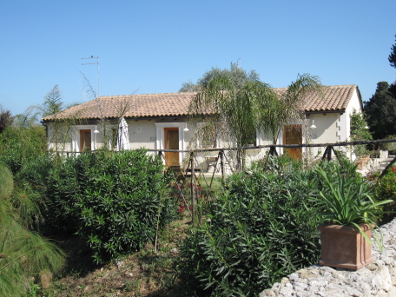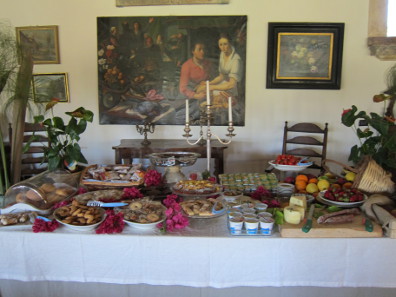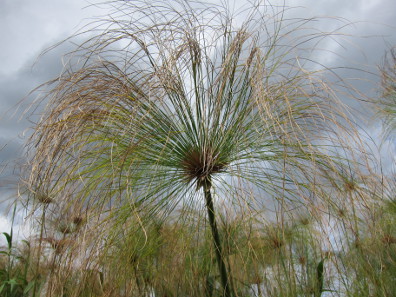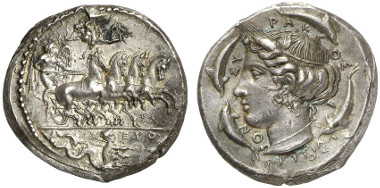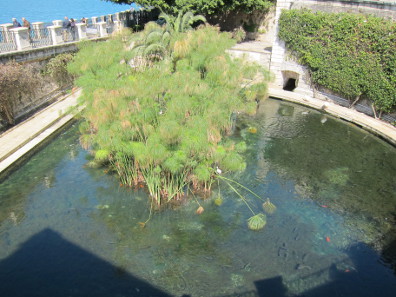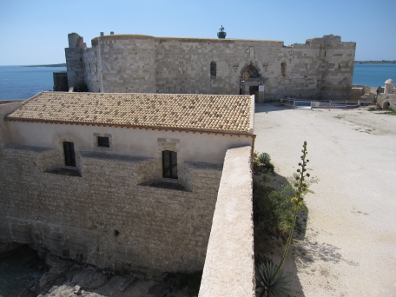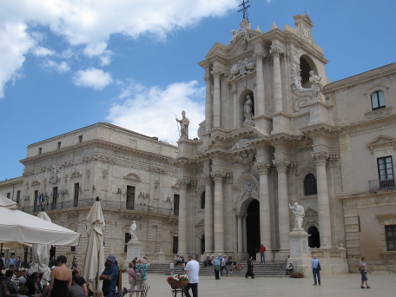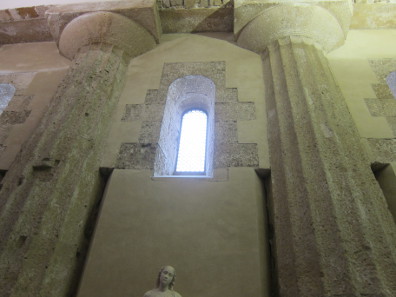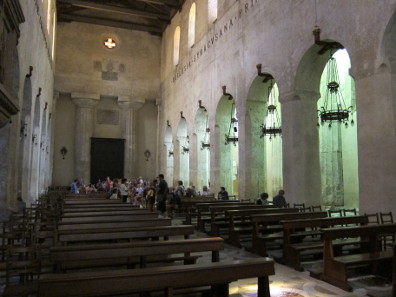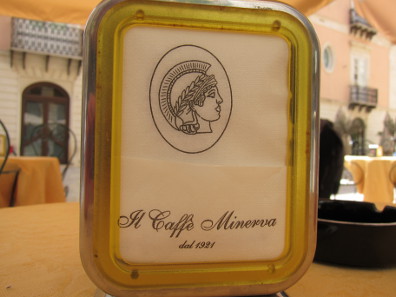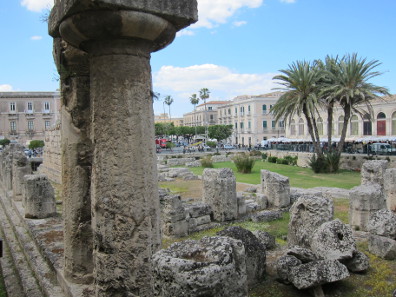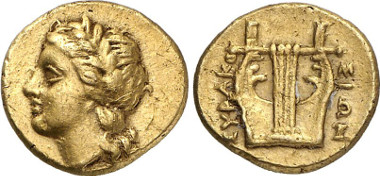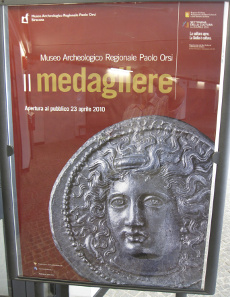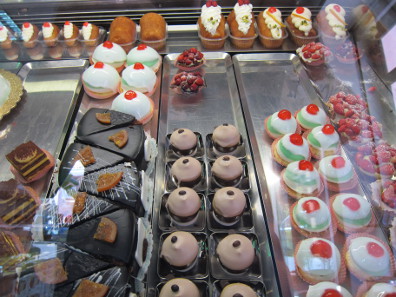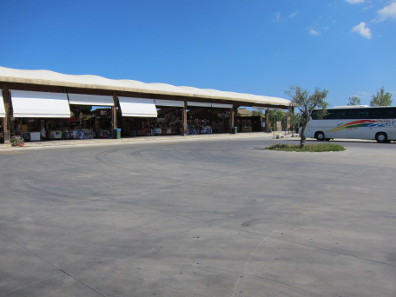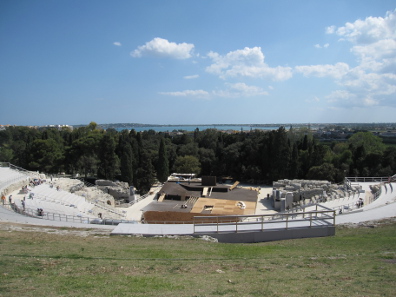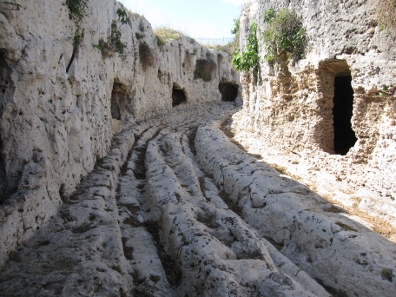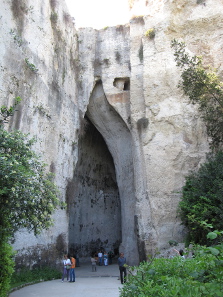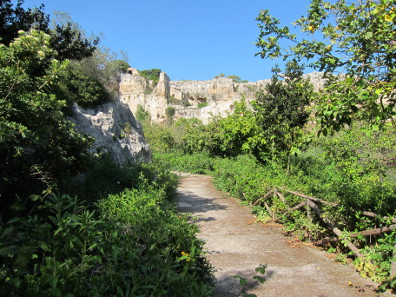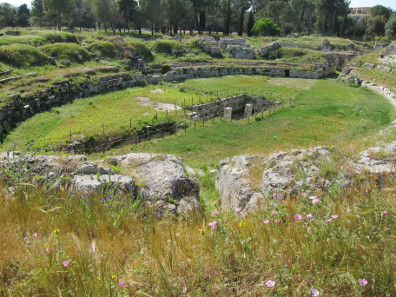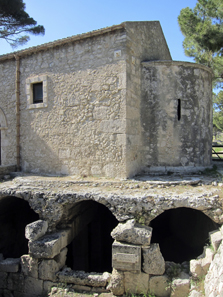by Ursula Kampmann
translated by Teresa Teklic
July 24, 2014 – Admirers of Greek coinage cannot help but go into raptures when you mention Syracuse. Oh the precious Arethusa heads, how they paint the image of Syracuse in our imagination! Oh noble simplicity and quiet grandeur! Spoiler alert: reality was somehow a completely different story …
Wednesday, April 23, 2014
Despite its friendly inhabitants and fine local cuisine, Akragas did not make it on the list of our favourite cities. Accordingly, we weren’t too sad to leave it for the centre of ancient Sicily, Syracuse. Finding an accommodation that suited us had been surprisingly difficult. Only an agriturismo with the idyllic name “Villa dei Papiri” had had capacities for us. A plus was definitely the Arethusa coin image on the website. Not so much this damning review on the internet: “AC was not working. Staff is not local and unprofessional, breakfast is a scandal for a so called agritourism in Italy.“ I don’t know what exactly Claudio Rocchetti, author of these statements, was describing, but it cannot possibly have been our agriturismo.
Instead of a single guest house, the agriturismo provides a number of smaller bungalows for its visitors. Photo: KW.
The rooms were small, but complete with everything you need and that at a, for Sicily at least, very high standard. Plus, every room comes with its own green area, sun shade, table, chairs and deck chair, a perfect recreation space after exhausting sightseeing tours. The staff was incredibly friendly and helpful. And breakfast …
Just a small glimpse of the huge breakfast buffet. Photo: KW.
… was the best we had in all of Sicily. Fresh fruits, freshly baked goods, local meat and cheese, homemade jams, fresh ricotta from the neighbouring farm, freshly squeezed orange juice and much, much more.
We tried to review the agriturismo ourselves in order to set right the previous slanting. Not a chance. It simply wouldn’t appear. Maybe we were defeated by technology. Or the agriturismo’s owners have powerful enemies somewhere, able to influence the Net …
Lemons in the lemon grove right at our doorstep. Photo: KW.
So, if ever you are in want of an accommodation near Syracuse, we highly recommend the Villa dei Papiri. The place has great flair and all ingredients for the perfect dream holiday. A small rivulet runs through the surrounding area, which includes a lemon and an orange grove. The place is of heavenly quiet, only disturbed by the chirping of the crickets and the lizards whizzing around.
River head of the Ciane. Photo: KW.
Just around the corner is a natural reserve with the spring of the Ciane at its centre. I imagine the source of the Arethusa, 2,500 years ago, must have looked pretty similar.
This source, too, was a holy place in Antiquity. It was dedicated to Ciane, a playmate of Persephone, who tried to prevent her mistress’s abduction. When she couldn’t prevent the misfortune, she literally melted into tears of grief, as Ovid tells us in his Metamorphoses.
Once a year, the Syracusani celebrated a public sacrifice to Ciane, during which a bull was drowned in the spring.
Papyrus. Photo: KW.
The spring is surrounded by papyrus on all sides and thereby one of the few places in Europe where papyrus can be seen outside of botanical gardens.
We rounded off the day with an excellent dinner in the restaurant a little way off that belonged to the same owners as the Villa dei Papiri. Simply put, it was delicious!
Later, we took a little stroll around the idyllic natural reserve, trembling with anticipation of the next day, when we would finally see Syracuse, the Promised Land of numismatics.
Thursday, April 24, 2014
We were again trembling the next morning, though this time not in anticipation, but in fear for our car, which was horrendously stuck in traffic on a multiple roundabout with an incomprehensible right of way regulation.
We finally found a way to a parking lot. Our first goal from there was, of course, the sanctuary, the spring of Arethusa.
Syracuse. Tetradrachm, ca. 415-409. Signed by “Euth” on obverse, by “Phrygillos” on reverse. From Gorny & Mosch auction sale 211 (2013), 85.
Arethusa was a nymph. When she was bathing naked in Alpheius, the river god saw her and desired to rape her. Arethusa tried to escape, but Alpheius caught up with her. As a last resort, the goddess Artemis changed the nymph into a spring and relocated her to Sicily. It is said that Alpheius’s desire was so overwhelming that he traversed the Mediterranean Sea just to merge his water with the spring in Syracuse.
Some authors find this kind of desire romantic. I don’t.
First of all, I ask myself how much Arethusa really enjoyed becoming a spring. I personally imagine life as a nymph much more interesting. Secondly, I wonder if Arethusa wanted to merge her water with Alpheius. Again, if you ask me, I would have declined with thanks.
Anyway, the Syracusani believed that they owed a freshwater spring on the island Ortygia to that miracle performed by Artemis. Reason enough to turn the place into a well-secured stronghold: the unlimited amount of freshwater could last any siege.
A freshwater spring on an island surrounded by salt water seemed like a miracle to the Syracusani, who took it as a divine sign, made Arethusa one of their primary objects of worship and devoted one side of each tetradrachm to her.
Arethusa today. Photo: KW.
Today, a high wall edges the spring of the Arethusa. Tourists lean over the railing. Sometimes they throw things into the spring … empty plastic bags, apple cores, paper … And so it didn’t really come as a surprise that ducks and goldfishes shared the nymph’s pond with rats. Yes, we saw a big, fat rat swim in the water. With naked tail. We turned away in disgust. Our pilgrimage had abruptly found its premature end.
Castello Maniace. Photo: KW.
We walked to the southernmost tip of the island, to the Castello Maniace, which is named after a Greek. Georgios Maniakes had successfully recaptured Syracuse for the Byzantine emperor in 1038. He was supported during this campaign by a guard of Varangians, as the Byzantines used to call the Normans. They were led by Harald Hardrada. When he became King of Norway shortly after, he didn’t constitute a danger anymore, but other mercenaries had eye-witnessed how easily prosperous parts of Sicily could be conquered. Voilà, and this is how the Norman conquest of Sicily started.
Under reconstruction. Photo: KW.
The fort’s Staufian ceremonial hall must be magnificent. Unfortunately it was under reconstruction. But at least we’d seen the fort this time. The last time we’d tried, we’d been chased away by armed soldiers as the fort was a restricted military area, although I still cannot imagine what reason could possibly have necessitated military presence in this area.
Palazzo Bellomo. Photo: KW.
Next, we visited the Museo Regionale di Palazzo Bellomo, a sight that is usually neglected by tourists, but actually more than worth seeing.
Annunciation by Antonello da Messina. Source: Wikipedia.
The museum harbours several incredibly beautiful Renaissance artworks. Precious highlight is the Annunciation by Antonello da Messina, which already foreshadows the famous painting in Palermo that we are, of course, still going to see later on our journey.
Even so, we eventually began to feel tired. And lazily walked over to the Cathedral of Syracuse, which also harbours a very special treasure.
Santa Maria delle Colonne. Photo: KW.
The Baroque main church of Syracuse, which is also seat of a bishop, is called Santa Maria delle Colonne – literally, “holy Mary of the columns”. However, the columns don’t refer to the Baroque facade …
Inside Santa Maria delle Colonne. Photo: KW.
but to the ancient columns integrated into the church’s walls. Formerly, this used to be the Temple of Athena, one of the most highly worshipped goddesses of Syracuse.
Syracuse. AE, 344-336. Athena’s head. Rv. Two dolphins surrounding star. From Gorny & Mosch auction sale 216 (2013), 2166.
After all, Syracuse was founded in 734 by colonists from Corinth. And colonies tended to keep the entire pantheon of their mother city. So did Syracuse. The temple dedicated to Athena was built already in the 7th century. But by the time the Syracusani converted it into a church in the 7th century AD, by simply bricking up the intervals between the Doric columns, it had long been replaced by another temple.
Inside Santa Maria delle Colonne. Photo: KW.
The walls of the cella, on the other hand, were broken through by eight round arches, so that it looked like the central aisle of a three-aisled basilica.
Baptismal font in Santa Maria delle Colonne. Photo: KW.
An ancient stone basin was converted into a baptismal font. It had already been part of the Temple of Athena and may have been used for similar purposes, nowadays and thousands of years ago. At least, we know that Greek sanctuaries used to have large, water-filled basins at the entrance, which were used by worshippers to cleanse themselves, as only purified visitors were allowed access to the gods.
The napkins at Café Minerva. Photo. KW.
We longed less for purification and more for food. Which is why we stopped at a traditional Sicilian café and indulged in “granita”, a kind of Italian ice cream that is particularly cold and contains more water than common ice cream.
The Arethusa fountain depicts the transformation of the nymph into a spring. Photo: KW.
Later, we discussed our further plans for the day. Many years ago, I’d seen the fantastic coin collection in Syracuse. It was very well hidden, back in the days. You had to know where to look for it: in a small room at the Soprintendenza, guarded by a friendly-looking police woman. And, knowing of its existence, you had to find this room. Which I did, by asking my way. When I finally entered the treasure room, I almost couldn’t believe my eyes. Forgive me for quoting myself at this point – I published an article on my impressions then in MünzenRevue of 1998: “3,000 of the finest coins are exhibited. Where to begin? With the 20 and more perfect Syracusan dekadrachms, minted by everybody who was anybody in the Greek die-cutting business? With the tetradrachms of Naxos, Katane and Kamarina (all of course extremely fine and better)? The countless fractions, which, in my whole existence as a numismatist, I had never seen before (or perhaps once, at most)? The first three rooms are dedicated to the individual Sicilian cities and provide a general overview of Sicily’s coinage. The fourth hall holds the collection of the Marchesi Enrico Gagliardi and his wife Maria Teresa. Here, the visitor will find many a showpiece from the realm of the Magna Graecia. Then, there’s another show room presenting Roman, Byzantine, Medieval and Modern coinage in Syracuse. But what really surprised me were the two halls dedicated to coin finds. The innumerable staters minted according to the Corinthian monetary standard weren’t exactly new to us, as we’d already seen them in Reggio. But Syracuse further has a number of finds from classical antiquity, amongst others one which includes the famous depiction of the Arethusa in frontal view by Kimon (later imitated on the coins from Larissa, for instance), the depiction of Athena in frontal view by Eukleidas as well as the two depictions of Apollo in frontal view on the coins from Katania.”
These days, we’d heard, the collection was supposedly much more easily accessible in the archaeological museum of Syracuse. To the museum!
Temple of Apollo. Photo: KW.
We walked past the Temple of Apollo, which was among the first large temples on Sicily. It was built around 570 and likewise converted into a Christian church. In comparison to the Temple of Athena, however, the older structures aren’t as well preserved because the church was eventually turned into barracks.
Syracuse, Agathokles, 317-289. 25 litrai, ca. 310-305. From Gorny & Mosch auction sale 203 (2012), 73.
Of course some Syracusan coins also depict Apollo, but he is relatively rare as a coin motif. Athena and Arethusa dominate the coin image – at least in the tradition of Syracusan coinage.
Entrance to the coin cabinet. Photo: KW.
Walking from the city centre to the archaeological museum takes about half an hour. It’s not a particularly enjoyable route, along pretty busy streets. When we reached our destination, we were tired and sweaty – but also excited about seeing the coin collection. But we met with bitter disappointment. No, we could not see the coin cabinet, it had been closed half an hour ago. I have heard the Italian word “chiuso” many, many times and learnt to interpret it. It usually means that the museum lacks staff or the staff the will to work. Consequently, show rooms that nobody wants to see anyway – at least not according to those in charge – are closed. Numismatic exhibitions always go in that category. But if you give them your best smile and insist VERY adamantly that you would really, really like to see the collection, that you came all the way just to see it and couldn’t they please, please let you in for just a short minute, you’re chances are usually good – if you appear humble enough. And so I kept insisting, politely, humbly, persistently. And the lady at the entrance was charming. She tried everything, but unfortunately everything wasn’t enough. At last, I found myself surrounded by five different employees, among them the museum’s own numismatist, all explaining to me why they couldn’t help me. Because the collection was closed. The keys in the possession of a pensioner. Who’d already gone home now. And no one else in the museum could open the collection. But this shouldn’t be a big problem, right, being a numismatist, I could simply swing by next year, when the congress in Messina would be held. Hmm. And if I didn’t want to wait that long, why didn’t I come back the next day, in the morning? Someone would definitely be there then, promised!
We were incredibly annoyed. And didn’t care a bit about the museum anymore. So we left the place.
Alfio Neri’s fairy cakes. Photo: KW
The one thing which relieved our misery was the best pasticceria in all of Syracuse, if not in all of Sicily. Several dozen meters away, on a really not-so-pretty side road, we discovered a small bakery with the most phenomenal choice of cakes and fairy cakes.
If you’re ever in trouble, been left by your girlfriend or denied access to a coin collection, don’t despair, but get yourself some fairy cakes from Alfio Neri, Via Pausania 3!
We were not counting calories, to put it mildly. We properly indulged in this delicious comfort food. And felt better afterwards. We decided to spend the day at the archaeological excavation site of Syracuse and try the museum again the next day. After all, we were free to make our own plans – unlike other tourists. And we would use that freedom to see the coins the next day.
The bus parking lot next to the archaeological excavation site. Photo: KW.
The archaeological excavation site was just around the corner. Only where to get the admission tickets remained one of the many mysteries of this island. We only discovered the ticket counter because, with our German sense of duty, we obediently followed the signs, even though they seemed to be pointing in the wrong direction in all likelihood. It turned out that the ticket counter was located way off, past a seemingly never-ending row of souvenir shops, whose products weren’t much of a temptation for us.
Altar of Hieron II. Photo: KW.
Armed with our tickets, we walked a good 15 minutes to the actual excavation site. On the way, we saw tourists of all nationalities bitterly complaining that there was no ticket counter in immediate proximity of the excavation site. We passed the enormous Altar of Hieron II, which must have once had the truly gigantic length of one stadium exactly. All that is left of it today, though, are the foundation walls: the edifice had been used as a quarry for the Spanish fortifications in the 16th century.
What they’ve done to the theatre. Photo: KW.
Next stop on our tour was the famous Greek theatre from the 5th century BC – probably a more impressive sight before they started to turn it into an event location.
Graves along the Greek road. Photo: KW.
Adjacent to the theatre is an area with numerous, fairly unspectacular tombs. Somewhat more spectacular is the road along which they are located. It features deep grooves which are said to origin from Spanish times when a water mill was located here.
The Ear of Dionysius. Photo: KW.
Simultaneously with three other tourist groups, we visited the Ear of Dionysius and witnessed the very questionable vocal performance of a tourist guide, who apparently believed himself to be the next Caruso. Only, what he didn’t take into account was that the special acoustics of the location amplified every note – even the wrong ones – 42 times. Not very favourable to his loud voice.
The Latomia del Paradiso. Photo: KW.
We escaped to the Latomia del Paradiso – an old quarry – and found a quiet place to sense the atmosphere. After all, this was the place where the infamous expedition of the Athenians to Syracuse had ended …
Remember how the Segestans had asked Athens for help against the hostile Syracusani? We told you the whole story during our visit of Segesta.
Let’s see. Back then, the Athenians were fighting the Spartans in the fifth year of the Peloponnesian War. They believed it would be a strategically clever move to conquer Sicily so they could force Sparta into surrender with the help of the additional Sicilian resources. Alcibiades, who had been made general, had to step down at the last minute due to his involvement in the vandalism of the Athenian hermai. He was replaced by Nikias, who had been strongly opposed to the campaign from day one. When the first year of the campaign ended without bringing any results, the Athenians decided to lay siege to Syracuse. The strategy didn’t work out. The Spartans had sent a reserve army, the Corinthians a small fleet – it was a recipe for disaster. The Athenians didn’t even manage to make an orderly retreat. The retreat of their huge army was cut off and thousands were killed. The 7,000 survivors were imprisoned in the quarry of Syracuse, which was then underground and since its collapse has been transformed into the scenic garden you see today. Those fit for work were sold into slavery, the rest died slowly and miserably in the darkness without ever seeing the sunlight again.
The amphitheatre. Photo: KW.
To prevent our own dying of thirst, we helped ourselves to some gorgeous, freshly squeezed orange juice on leaving the site. Thus reinvigorated, we plodded to the Roman amphitheatre. It was, by the way, one of the biggest of its kind in the Roman Empire. So this is where the Syracusani preferred to spend their free time by watching gladiators and animals rip each other apart.
San Nicolò dei Cordari. Photo: KW.
The last view that caught our eye before we left was the church St Nicolas of the ropemakers, whose telling name points to the area’s past and its flourishing ropemaking business in the 19th century. The high air humidity made the local grottos particularly suitable for the processing of the hemp. One of the historical grottos has been preserved until today, but has been closed for almost 30 years now due to danger of falling rocks.
But still, even from the paved trail you get a good view of the water tanks below the ropemakers’ church, which were once used to flood the amphitheatre in order to stage proper sea battles. The church itself was unfortunately not open for visitors.
That’s it. We were tired. We’d had seen enough for the day and stumbled towards our car.
We would see the coin collection in Syracuse tomorrow. Yeah, tomorrow …
Friday, April 25, 2014
The museum had barely opened its doors when we were already waiting to go in, filled with excitement to see the collection. Oh well. All those employees eager to help us the day before, who’d promised that we would be able to see the collection today, again were “very sorry”. It was a bank holiday, so the pensioner wasn’t coming to unlock the show room. They were really terribly sorry, but there was nothing they could do. They’d already told us that only the pensioner had the keys, hadn’t they. But tomorrow, tomorrow, we could definitely see the collection.
Well, tomorrow we’d have to return our car in Palermo by lunch time. As the museum doesn’t open before 9.30 am, it was technically impossible to squeeze in a visit to the coin cabinet. The custodian was of a different opinion. The solution was simple, couldn’t I see? Before coming into Palermo, we could rub our hands in dirt a little and just pretend to have had a flat tyre on the way to the car rental to explain our delay. Sure. What the helpful custodian didn’t tell us was what to do with the intact tyre.
So it happened that we never got to see the coin collection of Syracuse. And if anyone in Syracuse should ever wonder why so few people come to see this unique collection, they should really ask themselves how useful it is to open the exhibition for only a few hours every other day or so.
But this seems to be a common problem with many museums: not many at all are geared to the needs of their visitors. No wonder, most of these visitors only come once in a blue moon and don’t have a lobby. Those in charge of the museum, on the other hand, can do as they please. And if what pleases them doesn’t please the visitors, who cares?
In the next episode of “Sicily in full bloom” we’ll spend some more time in Syracuse before making our way to Palermo.
And here you can find all episodes of “Sicily in full bloom”.




